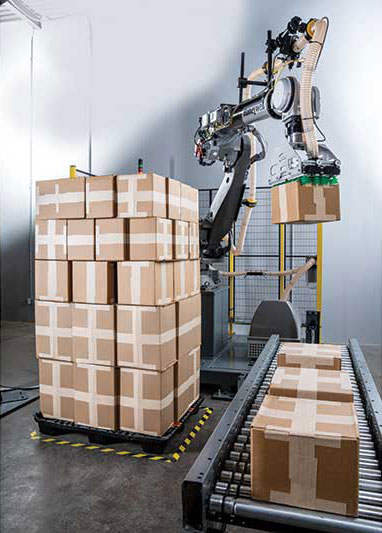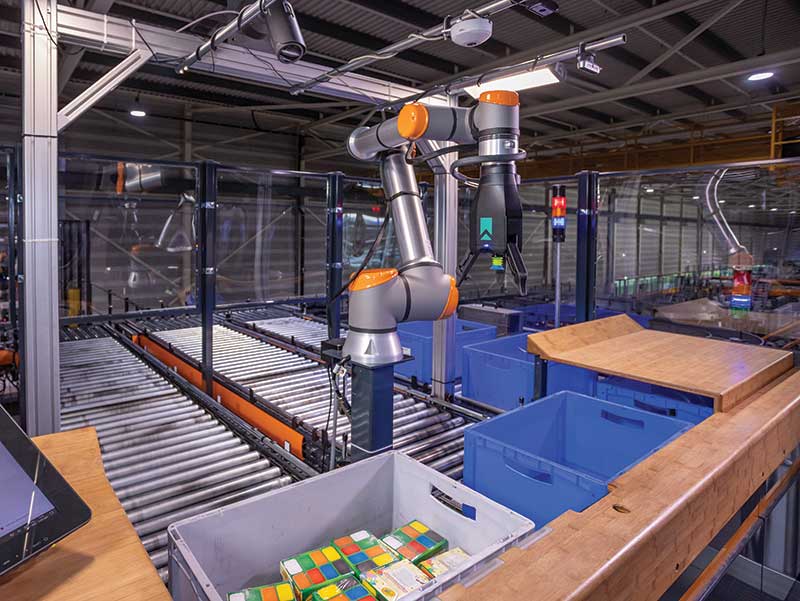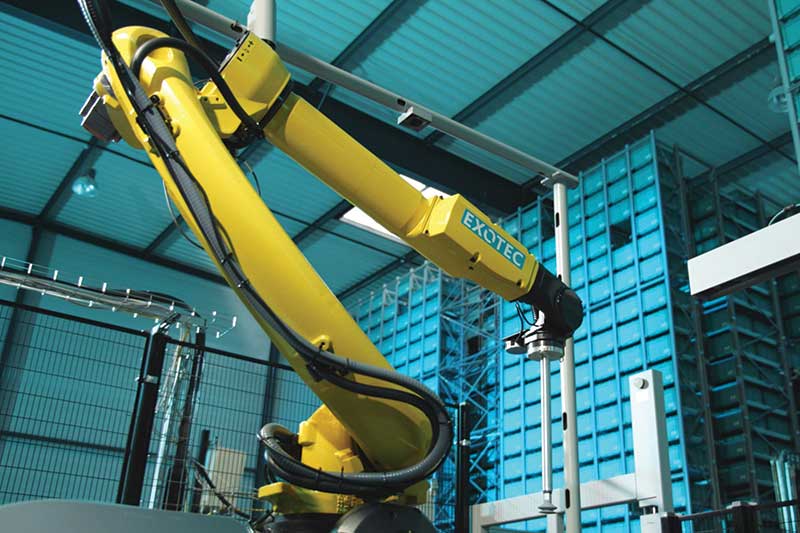The materials handling world’s love affair with the robot is as strong as ever, as anyone who plans to attend ProMat this month will see.
Of course, robots are nothing new to ProMat and its sister event Modex, with both events having featured robotics for about a decade now. This includes providers of autonomous mobile robots (AMR), as well as vendors of piece-picking robotic platforms using vision and artificial intelligence (AI) technologies to know how to manipulate items.
It’s a given that dozens of AMRs and piece-picking cells will be on display. Materials handling workflows are a good match for robotics, in that robots excel at either materials transport or item manipulation. The market has responded, with research firm Interact Analysis recently noting that mobile robot shipments grew at a 70% clip in 2021 and predicting that by the end of 2027, more than four million AMRs will be installed globally.
There won’t be quite that many robots at ProMat, but everyone will be talking about them. The deeper story is a maturing market. The focus is turning to high-value applications and integrated solutions, as vendors and end-users alike look to apply robotics in ways that join processes or automate some of the more physically demanding tasks in DCs.
Trailer unloading
For certain, one of the leading apps for AMRs has been assistive-pick bots that work in fleets, allowing human pickers to stay in a compact zone with minimal travel to improve productivity and throughput. Likewise, high-density automated storage and order picking systems are another widely used robotic application. But expect to see other robotic apps at ProMat, including trailer unloading.

Among the ProMat exhibitors involved with robotic trailer unloading is Boston Dynamics (Booth S2541), which recently announced that DHL Supply Chain has achieved the first commercial deployment of its Stretch trailer unloading robot at a DHL facility. AI-based robotic solution providers are increasingly targeting automated trailer unloading, especially with floor loaded cartons, including Pickle Robot Co. (Booth N6307).
Peter Blair, vice president of marketing and sales for Pickle Robot, explains that Pickle’s solution uses vision and AI as well as an articulating robotic arm on a mobile platform to autonomously unload trailers or ocean containers filled with loose-loaded cartons, rather than relying on a manual process.
Blair says the Pickle solution uses a mobile manipulation robot currently capable of picking 600 pieces per hour and “getting faster all the time.”
The main reason robotic trailer unloading is gaining interest, he adds, is that it’s a tough job when done manually, plagued by high employee turnover. “Manually unloading floor-loaded trailers and ocean containers is one of toughest jobs in distribution, with an even higher turnover rate in that role than in warehouse work,” says Blair. “So, if you can automate that with robotics, it’s an attractive solution for many operations.”
Currently, Pickle’s system can lift up to 100 pounds when grasping from above and up to 60 pounds when grasping from the front or “face” of a carton, which Blair says is how a robotic arm picks when unloading the topmost pieces.
Precisely how fast a robotic trailer unloading solution will perform, Blair adds, will vary by how neatly the cartons are loaded. If cartons are strewn about haphazardly, it takes longer to unload with a robot compared with a shipment with relatively tidy rows of cartons.
Honeywell Intelligrated (Booth S618a) through its Honeywell Robotics organization also offers automated trailer unloading with smart, articulated pick-and-place robotics. According to Thomas Evans, chief technology officer for Honeywell Robotics, the solution is currently being used by a large food and beverage company.
“We’re not only installing our robotic unloader, but adding new technologies and capabilities from our articulated robotics product set into the unloading capability that will continually enhance the product,” says Evans. “These include our newly designed end-of-arm tool to ensure optimum picking capability, integrating advanced machine learning and the next version of the navigation system to position the unloader more accurately for increased performance.”
Evans also sees depalletizing as a high-value robotics application for a manual task that is labor intensive. Evans notes that “several” companies are deploying Honeywell’s Smart Flexible Depalletizer in large part to mitigate labor availability concerns.

“The three key pieces of feedback and value we’re hearing from these customers using the Smart Flexible Depalletizer are reliability, uptime and throughput,” says Evans. “We’re meeting the performance metrics that businesses are looking for, and in working with customers, we’re able to show added value through co-innovation to meet their needs. This includes the ability to automatically detect and handle slip sheets, work with pallets up to 8 feet tall when built with consistent SKUs, and through our constant pallet mode, which automatically increases throughput when handling consistent layers or pallets.”
Robotic put walls
Robotics piece-picking platforms can be applied to many applications, including robotic put walls, which are offered by multiple exhibitors. Typically with a robotic put wall, a smart, articulating arm handles the “put” task into the wall’s cubbies, while associates staff the “pick” side.
Covariant (Booth N6951) offers robotic put walls and recently announced that Radial, an e-commerce fulfillment services company, deployed 12 of its U-shaped put walls to sort items from mixed-SKU totes into order cubbies.
According to Adam Fry, head of product with Covariant, robotic put walls are catching on because they fit easily into brownfield DCs and reduce the labor an operation needs to run high-volume put walls.
“Put walls are a tried-and-true process,” says Fry. “When you add robotics to it, you’re helping get the maximum efficiency from a process that exists in a lot of facilities today.”
Robotic put walls help a facility increase throughput with less labor, adds Fry, which might minimize the need to expand a DC network with new sites, additions or major automation projects, appealing to companies trying to stretch capital budgets. “Robotic put walls are an excellent application for brownfields and for customers really looking to take a step forward into robotics within their existing operations,” says Fry.

Goods-to-robot anyone?
Another leading use for warehouse robotics are goods-to-person (GTP) workflows in which automation like AMRs with rolling shelves, or some type of automated storage system, present goods needed to fill orders to a light-enabled workstation where a human picks the orders. The next logical step in automating this workflow is to use a robotic piece-picking cell in place of the manual pick station or window.
Call it goods-to-robot, or robot-to-robot, but it involves integration between automated storage and piece-picking robotics. Among those offering it is Vanderlande (Booth S603), which last year at Modex announced a partnership with RightHand Robotics (Booth N8107) to integrate Vanderlande’s GTP automation with a RightHand piece-picking solution.
“We’re seeing exceptional interest in the piece-picking arm from RightHand Robotics and are in the testing phase with some very well-known brands to fine-tune the workflows involved,” says Jake Heldenberg, head of solution design, warehousing, North America at Vanderlande. “The results we’re seeing are very pleasing, with the robotic picker and integrated workstation on average processing 600 totes with just one intervention per hour. This represents that the goods-to-robot system only sends items to the robot that it can effectively pick at scale, and I suspect those impressive numbers will only get better.”
At ProMat 2023, adds Heldenberg, Vanderlande will demonstrate a robotic piece-picking arm that integrates with its goods-to-picker 2.0 solution and gives e-commerce and omni-channel retailers “goods-to-robot” capabilities. “Interestingly, it’s also worth pointing out that we are seeing more interest in robots from DCs in rural areas,” Heldenberg says. “Not surprisingly, we expect most large-scale deployments of integrated robotic systems to initially occur in areas where access to labor can be particularly problematic.”
Other exhibitors with automated robotic storage such as Exotec (Booth N7325) and AutoStore (Booth N7500) also support piece picking. Exotec now offers a robotic picking arm called Skypicker that integrates and works with its Skypod system. Skypicker features machine learning-based vision that automatically detects each item’s dimensions to intelligently place them in containers and can reach outputs of up to 600 items per hour.
Carlos Fernandez, chief product officer at AutoStore, says the company has deployed more than 1,000 of its cube storage systems, and adds there are “several” projects where its systems have been combined with piece-picking robots. “Adoption of robotic piece-picking technology is continuing to advance as end customers express increased interest in the solution,” Fernandez says. “The ultimate goal is to increase the percentage of SKUs that can be automatically picked at a very high throughput rate, while maintaining low error handling.”
Robotic cube storage also carries the benefit of supporting more throughput from a relatively small DC footprint, given how they can use most of a DC’s full vertical height or “cube.” This aligns robotic storage with another trend: positioning inventory close to consumers.
“Between urbanization and growing population in dense geographies, paired with high customer expectations for faster e-commerce delivery, companies are being forced to allocate inventory in premium real estate areas that are closer to consumers,” says Fernandez. “As a result, space is a scarce and expensive resource. In addition, research estimates that e-commerce demands three times more warehouse space, as compared to traditional store transactions, which enhances the need for space utilization.”
Integration everywhere
Expect other exhibitors to stress integrated solutions, as well as vendors who offer software that allow multiple systems to work together, such as SVT Robotics (Booth N7148) or GreyOrange (Booth S3353).
For example, Berkshire Grey (Booth N6707) has teamed with AMR vendor Locus Robotics (multiple booths, including N8556), for a solution nicknamed “Project GreyWolf,” which combines BG’s Robotic Shuttle Put Wall (BG RSPWi) with Locus Robotics’ Origin and Vector bots, with the aim of using the bots to enhance take away and pack out processes from goods coming from a RSPWi system. The vendors are exploring further integrations with other of BG’s systems as well.
Chris Geyer, vice president at Berkshire Grey, says the Locus alliance exemplifies the “interoperability” theme BG is stressing in 2023. He adds that vendors need to provide integrated, streamlined solutions, while their robotic products need to be effective at rapid installation and the ability to handle a range of SKUs.
“RSPW has the ability handle both eyebrow pencils and shoe boxes, which gives it an enormous range of applicability,” Geyer says. “Many of our customers simply couldn’t otherwise adopt automation because they couldn’t find an autonomous solution with such a wide range of SKU eligibility.”
Another integration Locus Robotics has supported is between its bots and automated packaging systems, says Kary Zate, senior director of marketing communications with Locus. At several customer sites, he adds, the mobile bots integrate with on-demand packaging systems from Packsize (Booth S3547). “LocusBots bring orders to the Packsize machine, which then creates a custom carton for each specific order,” explains Zate.
Locus Robotics also sees robotics-as-a-service (RaaS) as an important trend with tangible end-user benefits. “[RaaS] subscription gives our customers a highly flexible, cost-effective way to optimize their productivity without having to tie up capital costs,” Zate says. “Another value our RaaS provides is there is no need for separate maintenance contracts, since everything is included, and the robots are constantly updated with the latest software and hardware, with 24/7 support and service.”
ProMat will probably present some new spins on what robots can do mechanically, but as a whole, we should see an increasing focus on high-value applications, measurable performance and integration—factors crucial to solving end-user pain points, of which there are many.
As Evans observes:
“The biggest issue warehouses currently face is the ever-changing workforce that has been impacted by the labor shortage. In addition to the number of open jobs to be filled, accelerating consumer demands for product variety and delivery speed are adding to the challenges that warehouses and distribution centers are encountering. Flexible automation solutions enable companies to offset current market trends impacting warehouse operations—including labor shortages, turnover and pressure on profitability due to inflationary measures—without adding more staff, expanding or building new facilities.”
About the Author
Follow Robotics 24/7 on Linkedin
Article topics
Email Sign Up
















